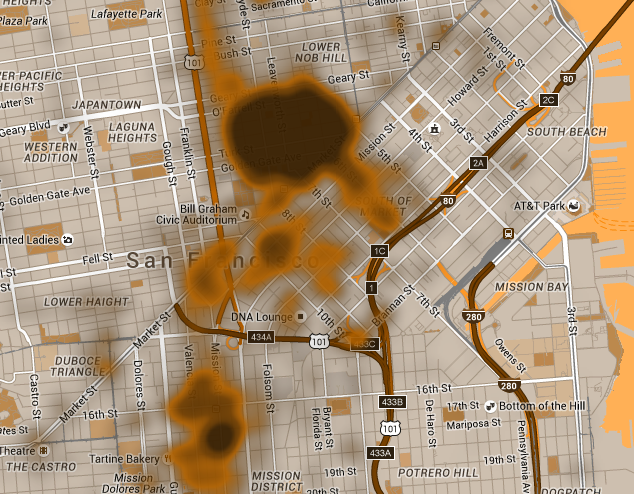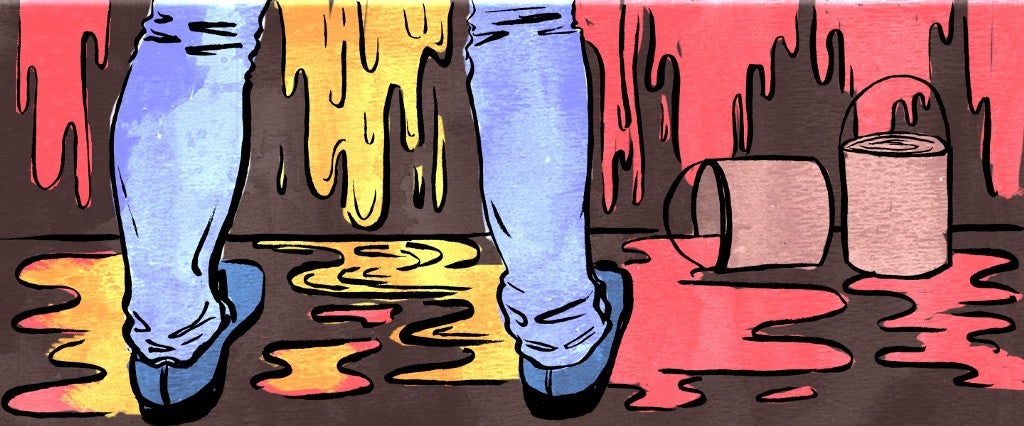San Francisco is famous for many things. Sourdough bread. Fog. Its recent influx of hoodie-clad tech workers. Among locals, it’s also known for something else: the massive quantities of human waste all over the city, from poop on Tenderloin sidewalks to pee-soaked walls in the Mission district. So last year, the city tried a new tactic: walls that pee back.
Of course, every city struggles with public urination, and punishments vary. In the U.S., cities set their own fines, usually a few hundred bucks. In some states, it’s enough to get you registered as a sex offender. In Brussels, there’s a 250 euro fine. In the U.K. town of Chester, offenders endure a walk of shame around the city to confront its urine-related damage. During Carnival, Rio sends patrols of workers into the crowds, rounding up mijões (pissers) and leading them to public toilets.
Last March, a community group in Hamburg, Germany tried a new solution. St. Pauli is a popular nightlife district, and the neighborhood was tired of partiers peeing in their streets. Fines didn’t help. So the group bought Ultra-Ever Dry, a hydrophobic coating that creates high points on a surface which forcefully repel liquids — in this case, directing urine back onto a person. The group painted it around the neighborhood, adding signs cautioning the wildpinklers (wild urinators): “Wir pinkeln zurück” (“We pee back.”)
“The problem [has] long existed in St. Pauli. It was clear — [the solution] must be cheeky and funny. Just like St. Pauli,” Julia Staron, a group member who led the project, said via email. In the project’s promotional video, Staron points at the camera with a warning: “From now on, it’s peeback time in St. Pauli.”
The paint seems to work. I tried both the San Francisco and Berkeley walls, squirting water from a sport-capped bottle, and the water bounced back over my shoes and pants at both locations.
Last July, San Francisco decided it was peeback time, too. After hearing about Hamburg’s solution, officials at the Department of Public Works were intrigued. Public urination has been illegal in San Francisco since 2002, and comes with a $50–$500 fine. Yet human waste remains a major problem for the famously small city, crowded by increasing numbers of homeless residents and young people drunkenly stumbling home from bars. Last year, a three-story lamppost fell and narrowly missed a driver, having degraded after years of being peed on by humans and dogs. Several enterprising programmers created data visualizations depicting the city’s increase in reports of human waste. When city officials asked a group of students in the crime-ridden Tenderloin neighborhood how they could help, the fourth- through eighth-grade students had a simple request: They just wanted to walk to school without having to dodge human pee and poop.

Last summer, the city painted nine walls as a pilot program. (The paint is a fairly cheap solution, costing a few hundred dollars per wall.) Now, Ultra Dry coats 15 walls across the city, including one in Russian Hill, one of the city’s most expensive neighborhoods. (Apparently, the rich like peeing in stairwells just as much as us proles.) After hearing about the program, a facilities manager at a Berkeley property management company coated walls of a urine-soaked alleyway, adding a stern sign: “I’ll pee right back at you if you try,” signed, “Mr. Wall.”
The paint seems to work. I tried both the San Francisco and Berkeley walls, squirting water from a sport-capped bottle, and the water bounced back over my shoes and pants at both locations. San Francisco Public Works regularly sends crews out for smell tests, and reported a decrease in urine smells. Yes, the program is a little silly, but that’s why it’s successful. “Part of it was the novelty,” said Rachel Gordon, Director of Policy and Communications for Public Works. “We want to get people’s attention, and it does work.”
Everyone from a Chinese TV news program to the BBC covered the San Francisco program, publicizing the issues around public urination — and the city’s need for more bathrooms — better than any dour public service announcement could. While homelessness rates are going down nationally, they’re continuing to increase in big cities, and cities are desperate for a solution to public urination: San Francisco received dozens of calls from other urban bureaucrats asking about the paint’s efficacy.
“We did a poop survey when we started… like, where are the piles of human feces?— and we found a lot of them were between parked cars, fire exits, places where people could have a semblance of privacy.”
One group just as intrigued by the paint’s new use is the company distributing it. “Absolutely not,” said Michael Hudgins, when asked if he ever expected the product — normally used by oil and mining companies to protect expensive equipment against corrosion — to be a weapon in the fight against public urination. Hudgins is an account manager with Maxx Sales, the Ultra Tech distributor that sold the coating to Hamburg and San Francisco. “We’re still laughing about it. Public urination is an issue many people have a problem with, and if we can help, we want to do that. Anytime there’s a moisture problem, we know this is potentially a solution.”
In San Francisco, Public Works plans to keep using the paint. But they recognize it’s a stopgap to the larger problem: The city needs more public bathrooms. As part of a new initiative called Pit Stop, they’ve started installing toilets across the city staffed by attendants to keep them from being used for sleeping, sex or drugs. Currently, there are 11, but they’re only open until 9 p.m. at the latest. The goal is to open as many as funding allows, and extend hours. Pee paint is a good deterrent, but the expensive bathrooms — each costs about $100,000 annually to maintain — are the real solution, according to Gordon.
“We did a poop survey when we started the Pit Stop — like, where are the piles of human feces — and we found a lot of them were between parked cars, fire exits, places where people could have a semblance of privacy,” said Gordon.
“You don’t want to have to squat between parked cars. You want somewhere where you can go. We want to give people appropriate places. It’s human dignity to give people a place where they can go. Really, it’s dignity.”
Shelby Pope is a writer in Oakland who has contributed to Lucky Peach, NPR’s The Salt, and Refinery29.
